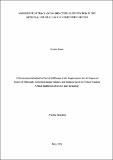| dc.description.abstract | Currently, the mining industry in Tanzania faces significant challenges including a significant
policy research gap. In this work, different indices were applied to assess the health risk of
people living and working in Rwamagasa artisanal and small-scale gold mines compared to
existing Tanzanian and international standards. This dissertation has focused on quantifying
and assessing the risk of selected trace and radioactive elements in a small-scale mining area.
Furthermore, the present study analyzed and thus gives some recommendations on issues
surrounding the Tanzanian mineral and mining policymaking process. Building on existing
work on miner’s health risk, the present study asks: What are the levels of trace and radioactive
elements in the studied mining areas compared to the recommended local and international
limits? What is the health risk due to trace and radioactive elements exposure to mine workers
and the surrounding communities? What are some of the deficiencies in the structure of the
Tanzanian mineral and mining regulatory framework that are relevant to the environment and
public health in artisanal and small-scale gold mines (ASGM)? The hyper pure germanium
detector (HPGe) was used for radioactivity analysis. The soil trace elements were analyzed
using the energy dispersive X-ray florescence (ED-XRF) technique. The radon gas levels were
measured using the Alpha Guard radon monitor. Different literatures survey digest were used
to assess the appropriate works on the regulatory and legal framework of the mining sector in
Tanzania. The levels of trace elements, carcinogenic and noncarcinogenic health risks revealed
that children were more at-risk compared to adults. The hazard index for all pathways was 1.77.
This index suggested that the residents of the studied sites were at a high risk of non carcinogenic effects due to mining operations. The carcinogenic risk for adults and children
was found to be 3.42×10-5
and 6.16×10-5
, respectively, which were higher than the tolerable
limit (1×10-6
). The results on radioactivity; mean effective dose; annual gonadal equivalent and
absorbed dose; radium equivalent; internal and external hazard indices; alpha and gamma
indices; and the radon gas revealed high values – approximately 60% higher than the levels that
were found in the control area. The Tanzania mining policy-making process needs to have a
circular model with the inclusion of scientific inputs as well as societal involvement at every
stage of formulation. The present study recommends further studies especially those that use
human samples and human subjects in attempting to discover more on the risk posed by mining
operations on human health. Also, sustainable mining awareness to people of Rwamagasa is
ii
recommended. Furthermore, the present study suggests developing a document that govern the
Tanzania artisanal and small-scale mining subsector. | en_US |

